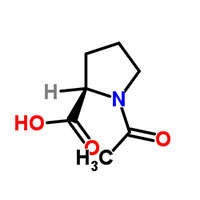Product Description
Introduction:
N-Acetyl-D-proline, also known as N-Acetyldihydroxyproline or NADP, is a crucial chemical compound with
significant applications in the chemical industry. This product introduction aims to provide an overview
of N-Acetyl-D-proline, covering its raw materials, production process, market trends, and the current
status of amino acids in the industry.
Raw Materials:
N-Acetyl-D-proline is synthesized using D-proline and acetic anhydride as the primary raw materials.
D-proline, a non-essential amino acid, serves as the precursor for NADP synthesis. Acetic anhydride,
derived from acetic acid, provides the acetyl group necessary for acetylation.
Production Process:
The production process of N-Acetyl-D-proline involves the following steps:
Step 1: Extraction of D-proline - D-proline can be obtained through various methods, including microbial
fermentation or chemical synthesis.
Step 2: Acetylation reaction - D-proline is reacted with acetic anhydride in the presence of appropriate
catalysts and reaction conditions to form N-Acetyl-D-proline. The reaction takes place in a solvent or
under solid-state conditions, depending on the specific manufacturing process.
Step 3: Purification and refinement - The resulting N-Acetyl-D-proline is purified using techniques such
as filtration, crystallization, and chromatography to achieve the desired level of purity.
Market Trends:
The market demand for N-Acetyl-D-proline has been steadily increasing due to its versatile applications
across various industries. Here are some key market trends:
Pharmaceutical Industry: N-Acetyl-D-proline finds extensive use in the pharmaceutical industry. It is
utilized as a building block in the synthesis of peptides and pharmaceutical intermediates. Its unique
structural characteristics make it valuable in drug discovery and development processes.
Cosmetics and Personal Care: N-Acetyl-D-proline's moisturizing and anti-aging properties have gained
attention in the cosmetics and personal care industry. It is used as an ingredient in skincare products,
particularly those focused on hydration, collagen synthesis, and wrinkle reduction.
Food and Beverage: N-Acetyl-D-proline is also employed as a food additive and flavor enhancer. It can
improve the taste and aroma of various food products, including soups, sauces, and savory
snacks.
Current Status of Amino Acids:
Amino acids play a vital role in various sectors, including pharmaceuticals, food additives, animal
nutrition, and agriculture. The demand for amino acids continues to grow due to their diverse
applications and essential role in biological processes. Amino acids, both essential and non-essential,
are widely utilized in the industry.
Conclusion:
N-Acetyl-D-proline, derived from D-proline, holds significant value in the chemical industry. Its
production involves the combination of raw materials and precise manufacturing processes. The market
demand for N-Acetyl-D-proline is driven by its applications in pharmaceuticals, cosmetics, personal
care, and the food industry. Amino acids, including D-proline, continue to play a vital role in various
industries, and N-Acetyl-D-proline maintains its position as a valuable chemical compound with diverse
applications.





